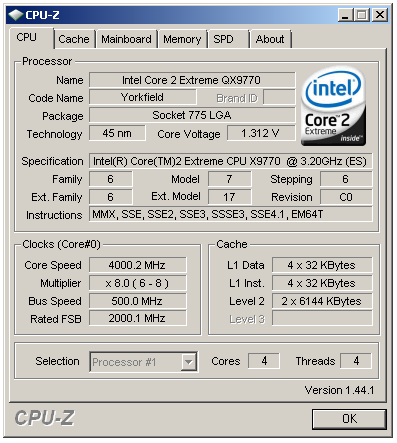ASUS Striker II Extreme: Mucho Bang, Mucho Bucks
by Kris Boughton on April 11, 2008 7:00 AM EST- Posted in
- Motherboards
Intel 45nm Quad-Core Overclocking
Perhaps the greatest ability the ASUS Striker II Extreme has to offer is its amazing performance when overclocking 45nm dual-cores, 45nm quad-cores, and high-speed DDR3 memory. We have tested numerous motherboards built on many different platforms with several different chipsets but none has performed as well as the ASUS Striker II Extreme when it comes to overclocking our Intel QX9770. A little time spent with tweaking the GTL reference voltages and we found ourselves starting at a Prime95 stable system running a 45nm quad-core at 500MHz FSB.
 A 45nm quad-core at 500MHz FSB? Doth my eyes deceive me? |
We then turned our sights to memory overclocking and decided to see just how far we could push 8GB of OCZ DDR PC3-14400 Platinum Edition memory. One of the secrets to running high physical memory densities - whether DDR2 or DDR3 - is tRFC, an important memory timing parameter, necessary for the proper refresh of SDRAM circuitry. Although JEDEC provides different tRFC minimum value specifications for each device density, most overclockers ignore these values when it comes to achieving maximum system performance.
 While DDR3-2000 memory speeds may no longer be impressive to some, we tend to believe seeing this with 8GB of DDR3 is quite an accomplishment for today's boards. |
Because of the design of memory, SDRAM must be periodically refreshed in order to retain the validity of data stored in each memory cell. All banks of the SDRAM must be precharged and idle for a minimum of the Precharge Time (tRP) before this refresh command can be applied. Once the refresh cycle has completed all banks of the SDRAM will then be in the precharged (idle) state and a delay between the Refresh Command and the next Active Command or subsequent Refresh Command must be greater than or equal to the Refresh Cycle Time (tRFC).
Higher memory device densities with a greater number of SDRAM banks require more cycles to complete this refresh sequence. The number of clock cycles needed to satisfy the tRFC minimum specification for a system configuration consisting of a pair of 2GB modules, although not double that of 1GB modules, is still significantly higher - about 53% higher according to JEDEC figures - and installing four separate modules in place of two makes consideration of this timing even more critical.
 This is just the level of performance we have come to expect from DDR3. The fact that we can achieve this with 8GB though is simply awesome. |
Our greatest memory performance point actually came at DDR3-1600 (500MHz FSB and a 5:4 divider) with 8GB of memory. We could not get the system to run without errors with 8GB at DDR3-2000 with "P1" and "P2" enabled (we will talk more about these particular settings later in the BIOS guide). Backing down to DDR3-1600 and enabling these values boosted our memory read scores to almost 12GB/s.










23 Comments
View All Comments
seamusmc - Friday, April 11, 2008 - link
For folks considering this board, I strongly recommend visiting xstremesystems.org's forums.Several people are experiencing data/OS corruption when performing any FSB overclocking. (Brings back memories of the early days of the 680i.)
nomagic - Friday, April 11, 2008 - link
LGA775 Core2 Duo/Extreme/Quad, Pentium EE, Pentium D, Pentium including next-generation 45nm CPU supportWhich would include Nehalem, I suppose? Should I also assume that a BIOS update would be required for Nahalem support? Is it possible that a custom board like this might have trouble supporting Nehalem when the times comes?
TemjinGold - Friday, April 11, 2008 - link
No. NOTHING out right now can support Nehalem as that's a completely different socket (different pin count too).